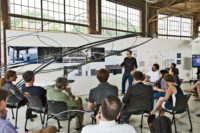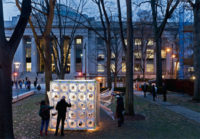The new documentary, Kevin Roche: The Quiet Architect, shown last month at the Architecture and Design Film Festival in New York, naturally brings up the question about the future of the firm, Kevin Roche John Dinkeloo and Associates. Roche is 95. What plans for succession are in place at the Hamden, Connecticut, office? It has been functioning since 1966, although partner John Dinkeloo died in 1981 at age 63. Dinkeloo, trained as an architect and engineer, was instrumental in establishing the firm’s reputation for such technical advances as the use of metal deposit mirror glass and of Cor-Ten steel in its buildings. After his death, there were fewer similar innovations, although Roche Dinkeloo continued garnering important commissions for cultural institutions, universities, and office buildings.
Currently another Dinkeloo has emerged at the helm. A recent reorganization of the almost 50-person practice led to John’s son Christiaan’s returning to the firm after almost 20 years to assume the role as principal along with Roche. He supervises design through construction of their projects—the biggest one currently is for two buildings in Capitol Crossing, a mixed-use complex in Washington, D.C., along with Skidmore, Owings & Merrill (the master planner) and Kohn Pedersen Fox.
Christiaan Dinkeloo was born in Detroit in 1956, when his father and Roche were with Eero Saarinen’s office in Bloomfield Hills, Michigan. The son went to the University of Michigan, as had his father, and graduated in 1981 with a B.Arch. Immediately after school, Christiaan headed to Roche Dinkeloo in Hamden. RECORD recently talked with the younger Dinkeloo about the firm’s future.
Architectural Record: You joined the firm right after your father’s death. It must have been daunting to arrive at this time.
I had been working with the office since the seventh grade. This was my architectural home.
However, you left in 1989 to start your own practice in New Haven. Why?
I felt I had a wealth of experience and wanted to apply that to differently scaled projects, with a small firm—we started with four and expanded to 10. The size has advantages: projects get executed more rapidly, and we developed a real hands-on experience with residential, office, retail, and university work.
Then you came back to Roche Dinkeloo in 2013. What happened?
Kevin and I had been talking for a number of years about my returning. Two of his partners were almost 80 and looking to retire, and I wanted to practice again with him.
But 80 is young in your firm! How is it working with a 95-year-old?
Kevin is amazing. He comes to work every day, five days a week. I enjoy collaborating with him. With our level of experience, we have a wonderful synergy in spite of the 35-year age difference. In terms of his design approach, each project is unique. No matter what the commission, the solution starts with the end user. Kevin spends a long time on the concept. Then the staff develops it, and he critiques it.
And your role?
I execute Kevin’s designs to the best of my— and everyone’s—ability. This is much the same as my father, who knew how to turn Kevin’s concepts into reality.
There will be a day when Kevin is not here. What is the plan then?
We have a handful of designers who have worked closely with him. I can’t name names now, but some have been working with Kevin—and the clients—for years, as part of the design process. We look on our place as a palimpsest, where you can see the underpainting beneath the newly painted surface.
You have an unusual situation. What are the challenges you see?
This is really one of the few postwar firms to still operate under a founding partner. When this firm started, getting work depended on relationships and reputation—a chairman of the board would just call Kevin. Now real-estate and facilities people do that. Many firms are in their second and third generations, but there is no personality guiding them or the vision. Firm names are given initials instead of the names of the principals, and marketing and publicity people handle getting new commissions, which come shaped by the market. It’s a different world, but we plan to make it work.








Post a comment to this article
Report Abusive Comment